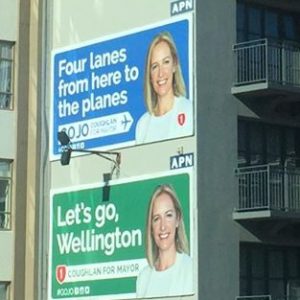The show begins: Election 2019
It’s that time again (yes, it’s come pretty quick). Candidates for local body elections are starting to emit policy information to appeal to you, The Voter! Can one see what candidates actually stand for amid the “I stand for Motherhood and Apple Pie, and Lower Rates”? Talk Wellington unpicks some early starters
Transport will be a big 2019 election issue for the whole Wellington region.
Councillors Diane Calvert and Simon Woolf have run their colours up the mast for us all to consider, in a press release on the excellent Scoop Wellington.
Their transport-specific comments are interesting. Note: they’re amongst quite a lot of stuff, which we generally like the sound of, without having dug into it much – housing and culture and better frontline services. Nice.
But because Talk Wellington is still calling this the Year of Transport (LGWM having not yet come out), we’re looking a bit more closely at these transport comments.
We’ll pull out each of Woolf and Calvert’s transport-related comments at a time. Here we go…
Consider the establishment of a Regional Transport Authority to improve delivery of transport infrastructure and transparency of information to the people, of not only our city but for the whole Wellington region
First the good stuff in here: It’s great to consider a regional transport authority. The disconnection between Wellington’s bits of transport governance – and thereby its planning, investment, delivery – is really quite breathtaking. We’ve had posts about this before, like here and here, and will again. This is one of those topics that either gets flippant thinking (Stuff commenters’ “get rid of [council x], fire them all!”) or nothing (the Regional Land Transport Plan process is working fine for Wellington thankyou, nothing to see here).
So openness to talking about better structures is good!
And transparency is definitely an issue. (It’s depressing to see how little proper data councils, NZTA and Let’s Get Wellington Moving are willing or able to openly release, despite the government’s long-standing commitments. See for example Metlink.)
But Calvert and Woolf’s statements we also find really frustrating. They’ve got this focus on “improve delivery of infrastructure” – an output – rather than “improve people’s transport options” or some other outcome.
This really matters, and it seems strange that people in governance should confuse an output with an outcome. (Though in the comments, Calvert does clarify a phrase she says “could have been worded better”, so perhaps we’re asking too much.)
And call us cynical if you will, but it’s a known fact of life that “infrastructure” i.e. “things we can be photographed cutting a ribbon in front” is to politicians what catnip is to cats.
Especially those seeking re-election. And whether or not that infrastructure actually improves the world for anyone is “hey, I’ll deal with that if I get elected! At least no-one will say I didn’t Get Things Done!”

Woolf and Calvert’s next line is…
Support the development of improved roads, bridges and tunnels from The Terrace through to the airport to improve connections with the east and south and enable safer and more open space within the CBD for pedestrians, cycling and activities.
Oh here we go.
“support the development of better roads, bridges and tunnels…” Output output output. Damn, we were right about the catnip.
Dear readers, we’re going to make an assumption here. We’d love to be wrong. Oh how we would love to be wrong.
Assumption: when Calvert and Woolf say “better” roads, they don’t mean “roads put on a road diet so they’re less traffic-dominated and more people-focussed”. Nope.
If we’re correct in that assumption, it means we can take these statements in a certain light:
“…from The Terrace through to the airport to improve connections with the east and south and enable safer and more open space within the CBD for pedestrians, cycling and activities.”
- “to improve connections with the east and south” yet “pedestrians, cycling and activities” only mentioned with reference to the CBD. Hmm. In light of the assumption above, and also on its face, does anyone else think this smells like “We’ll have four lanes to the planes because that’s how you get better services for people in the CBD”? (Please please let us be wrong about their intentions…)
- Where exactly do Woolf and Calvert think all the cars are going to go in Wellington once induced demand hits? (Note: it’s already hitting up the Kāpiti coast thanks to the larger roads, and car-focussed greenfields development).
- Will they be fielding complaints when people, promised what feels like a motorway-grade driving experience in Wellington city “cos they told us the tunnels were bigger to address congestion”, end up in a series of stop-start congested traffic lights between the Terrace and Mt Vic and into Hataitai? Which are there because… there’s a city here and it’s full of local streets and loads of people living and going about their business…

“Four Lanes To The Traffic Lights”? Definitely doesn’t scan with the focus groups.
Back to Woolf and Calvert. Their next transport-y bullet was:
Support further development and partnership with central government for public transport to meet the current and future needs of patrons travelling from the CBD through to the east and south of the city. Ensuring any proposed investment has a strong business case, affordable for city ratepayers and not a disproportionate burden.
This sounds good. We like strong business cases. We like proportionate burdens, especially “future needs” -– hooray! And we like the sound of partnership with central government on public transport. The local government funding model is fundamentally broken and public transport is one manifestation. (And we’d better rattle our dags fixing that model, because climate change is going to kill councils’ budgets.)
But in the context of the previous paragraphs’ clangers we can’t really give many points on this.
(Still hoping we’re wrong about them!)
It’s so important to be able to unpack politicians’ statements on complex issues, and press them for actual commitments to and against certain things. But it’s difficult!
Here’s hoping the excellent Massey University / Spinoff collaboration Policy will be doing their good stuff for the local body elections. Generation Zero and Regional Public Health are also great at unpacking the “motherhood and apple pie, infrastructure for all people” kind of statements, so keep an eye out.
As a prospective voter, how do Calvert and Woolf’s policies feel to you? Let us know in the comments…
Do you know other sources of insight for unpacking politicians’ pre-election policy-speak? Let us know!
Image credits:
- Banner image: Onepixel
- Ceremonial scissors: Tedium.com
- Jo Coughlan mayoral campaign billboards: from the daily blog
Leave a comment